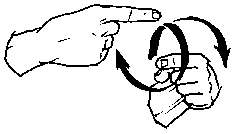GO: "go to"
The sign "go" has a single, quick
movement:



Note: if you do the "GO" sign
twice, it means "attend" as in "I've been going to UCLA."




Here is a variation of the concept of "going"
that I noticed during my travels. It basically means, "Hey, let's jam!" Or,
"I'm out of here!"
GO [variation / not recommended / slang]



"Go" as in "TAKE-OFF"
Here is a favorite of mine. It means "take off," "let's
jam," or "hit the road." If you use a smaller, double motion it can mean "run"
as in "The printing press is running or producing the
pages." Note: The non-dominant hand doesn't move much in this sign.
The movement is in my right hand. Also see: LEAVE





When I was young I used to see this variation show up on the hands of signers
who were using Signed English. This version is done by pointing both index
fingers toward each other. Rotate both fingers around one another. Move both
hands away from your body.
GO [not recommended / Signed English]

DISCUSSION:
In a message dated
3/31/2007 8:23:09 A.M. Pacific Daylight Time, kerbyhouse@
writes:
Dear Dr. Bill,
I see “go” as throwing fingers forward and
also, sideways as well as two fingers rolling forward as like 2 wheels rolling
forward. IS there a difference as in “We are going to the store” and “here we
go!”? I saw a couple signing with their child at Disneyland the other day and
they signed “go” like bicycle wheels and then I see Rachel (Signing Time) sign
go as throwing fingers forward/sideways (angular?) but in my book, the author signs it
throwing them forward. Why are there so many different ways? According to the
excerpt, [in the book] as long as you mouth the word with the action, it signifies “go” went
“going”….etc. Is that correct?
- Kerby
Dear Kerby,
1. Generally the ASL sign for "GO" is done by "throwing" the index fingers forward.
(The tips of the index fingers tracing an arc in the air.)
2. Throwing the index fingers to the side is another very popular version.
3. The sign can be "directional." If you are going to a specific place that is in a certain direction you can
incorporate that information into the sign by "throwing the index fingers" in
that direction.
4. The rolling version of the sign "GO" is more of a "Signed English"
version of the sign and is not commonly used by skilled adult users of ASL when
signing to other skilled adult users of ASL. In your example the adult couple
was signing to a child. This could be an example of "motherese" or perhaps the
individuals did not know ASL and were using Signed English.
5. Concepts like "Here we go!" might not incorporate the sign "GO" at all.
Instead, in ASL, you would sign something more to the effect of, "READY?
PROCEED!"
6. "Mouthing" is a complex topic. While it is indeed common to see mouthing or
"partial mouthing" of words in the Deaf Community it is an overstatement to
declare that a person "should" mouth words while signing. Some signs require
specific mouth movements that have nothing to do with voiced English. For
example, mouthing the English words "not yet" while signing "NOT-YET" will
result in an incorrectly produced sign.
Also see: LEAVE (go
away / go away)
Also see:
COME